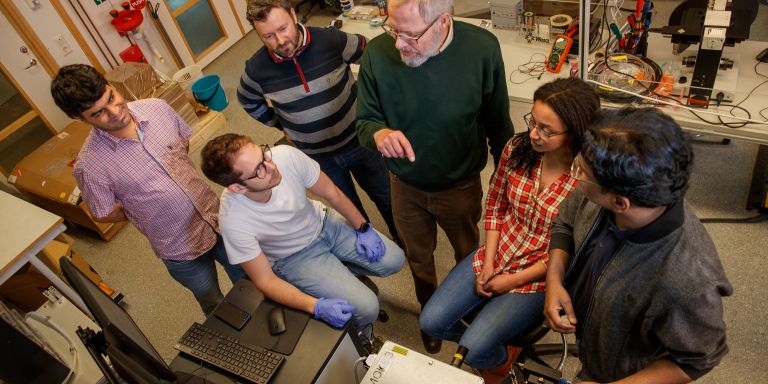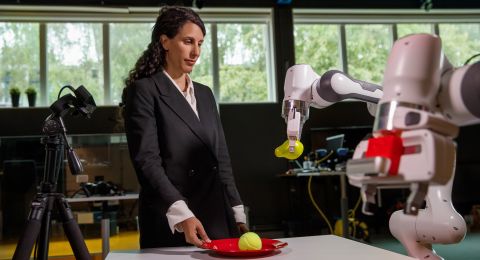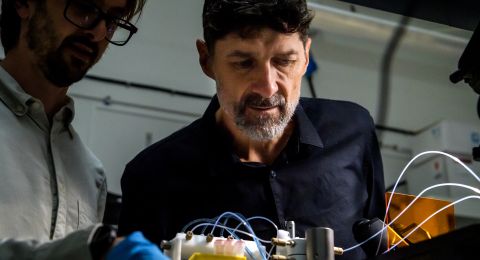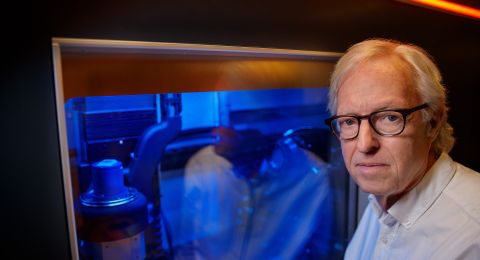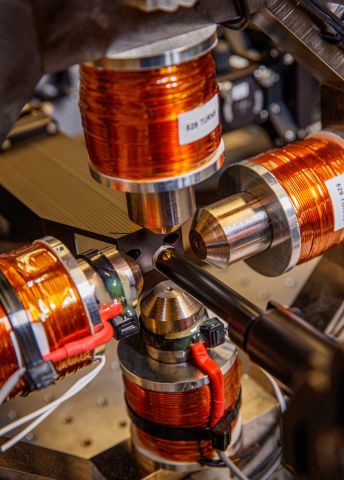
Project Grant 2022
Harnessing orbital angular momentum for novel orbital electronics
Principal investigator:
Peter Oppeneer, Professor of Physics
Co-investigators:
Uppsala University
Mahmoud Abdel-Hafiez
Venkata Kamalakar Mutta
Jan Rusz
University of Gothenburg
Johan Åkerman
Institution:
Uppsala University
Grant in SEK:
SEK 36.1 million over five years
Today, the electron spin is used as an information carrier, for example in magnetic reader heads of hard disks and in magnetic computer memories. But researchers are now examining the possibility of instead using another property of electrons, known as “orbital moments,” as an information carrier. Peter Oppeneer, who is a professor of physics at Uppsala University, explains:
“Our scientific research may ultimately result in a technology capable of revolutionizing electronics through the use of much more sustainable materials and energy-efficient components.”
Oppeneer is heading a project funded by Knut and Alice Wallenberg Foundation that involves five research teams. The idea is to combine theoretical and experimental expertise to study this new field.
Orbital motion of electrons
Orbitronics aims to use the orbital motion of electrons to transfer and control information, instead of merely using their spin moment or charge.
A better understanding may be gained by considering the behavior of electrons.
Electrons orbit the atomic nucleus at energy levels that are termed electron shells or orbitals. The rotational motion of electrons themselves is called spin, and creates magnetic properties. But the researchers are now interested in the orbital moment, which is linked to the way electrons orbit the nucleus.
It is possible for scientists to alter the orbital motion of electrons, e.g. by applying an electric current or a magnetic field to an electrical component. This creates orbital currents, which may in turn be used to influence and control magnetic properties in electronic components and memories.
“The field offers enormous potential, and thanks to the project funding from Knut and Alice Wallenberg Foundation, we can adopt a synergetic approach to these questions,” says Oppeneer.
New research field
The research is in its infancy. Apart from the Swedish researchers there are just a few teams in the world working in this field.
A theoretical breakthrough occurred in 2018 when a research team in South Korea published a study that attracted widespread attention. The researchers based their work on the “Spin Hall effect,” on which modern spintronics is founded. This effect is achieved by converting a charge current into a spin current, which can then be used to control the magnetic memories.
“But the researchers in South Korea demonstrated really exciting findings – that the ‘Orbital Hall effect,’ as it is now known, is two magnitudes greater than the Spin Hall effect,” Oppeneer explains.
“And shortly after that my research team demonstrated that enormous orbital effects occur where a material lacks inversion symmetry, e.g. at the interface between two metal layers. In theory, this means we ought to be able to exploit powerful orbital effects in innovative orbital components.”
Oppeneer and his fellow researchers are now further developing the theory. As part of the project they are collaborating with researchers who are developing experimental methods for examining and confirming the theoretical predictions.
Mapping new materials
The project includes a study of new materials and methods for creating and controlling orbital currents. Among other things, the researchers are studying graphene, an ultrathin material one hundred times stronger than steel. Graphene is a good conductor of electricity and has a number of other favorable properties for use in future products.
“It would be fantastic if we could demonstrate that orbital-based transport works in two-dimensional materials such as graphene,” Oppeneer enthuses.
One hurdle is the next step required to build orbital components. But this, too, forms part of the project via Johan Åkerman’s research team in Gothenburg.
“It’s a challenge not only to be able to demonstrate orbital effects, but also to show in practice how we can derive benefit from those effects. You have to know exactly how to build a component to achieve the major effect,” Oppeneer says.
If the research is successful, it may ultimately pave the way for new and “greener” electronics. Components based on orbitronics may be much more energy efficient, but that is not their only advantage. Current spintronic technology is dependent on costly and hazardous heavy metals and minerals such as platinum, tungsten or tantalum. The use of orbital currents offers the prospect of using completely different materials.
“We could use a broader class of materials – materials that are lighter, cheaper and greener, lessening our dependence on ‘conflict minerals,’ as they are known.”
Oppeneer is hopeful.
“One long-term goal of our project is to develop a prototype demonstrating that orbitronics is better than what can be achieved using current spintronic technology.”
Text Nils Johan Tjärnlund
Translation Maxwell Arding
Photo Magnus Bergström
